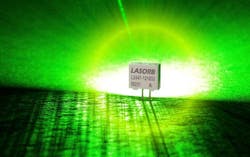WILLIAM R. BENNER JR.
Laser diodes have two distinct failure modes that conventional electronic components do not have: one is related to junction failure, which is essentially electrical overstress; and the other is related to mirror failure, which is essentially optical overstress. Most electronic components are based on simple p-n junctions. By contrast, laser diodes are electrically like PIN diodes, based on heterojunctions. During a surge, the heterojunction is more susceptible to damage than the p-n junction used on conventional components.
Laser diodes also have integral mirrors that are designed to withstand only a maximum prescribed light level, but not much beyond. During a surge, the laser light output can increase to a level that exceeds the maximum, ultimately causing damage to the mirrors.
Conventional electronic surge protectors fail at completely protecting laser diodes from electrostatic discharge (ESD) and power surges. These surge protection components work by attempting to clamp the maximum voltage level across the device’s terminals to some predetermined maximum. Of course, the clamping voltage must be higher than the maximum operating voltage of the device to be protected.
To complicate matters, the operating voltage for laser diodes varies with time and temperature. For example, a 520 nm green laser diode may have a typical operating voltage of 6.4 V and a maximum operating voltage of 8 V. If a conventional ESD protection component is chosen to have a clamping voltage of 8.1 V, this is actually more than 25% above the typical operating voltage level.
Even using a modest dynamic impedance of 1 ohm, this 25% increase in voltage may represent an 8-fold increase in current. Clearly, the laser diode cannot withstand an operating current increase of 8X, even for a brief time, so this simple example illustrates why a simple clamping approach is ineffective.
A change-of-voltage approach
We developed a different approach to laser diode protection, called Lasorb, which is a hybrid electronic component that is connected directly across the anode and cathode terminals of a laser diode. With this connection, Lasorb can monitor the instantaneous voltage across the laser diode, including any changes of that voltage as well as reverse bias (see figure).
As its primary method of protection, Lasorb includes a slew-rate detector, which monitors the slew rate of the voltage across the pins of the laser diode. If there is a fast change-of-voltage condition detected, this triggers the device to aggressively conduct the voltage (and thus current) away from the laser diode. The conduction is initiated very rapidly—in some cases less than one nanosecond—and the conduction can last from several microseconds to tens of microseconds (the actual slew rate, surge conduction time, and maximum operating voltage can be specified).
This change-of-voltage approach is a good principle to use for laser diodes because, under ordinary circumstances, even during modulation the voltage across laser diode pins does not change very much. Therefore, any change of voltage, especially a fast one, indicates an abnormal event—something that happens only during ESD or other types of electrical faults. This method allows the device to protect a laser diode at all times, whether it is lasing or not.
During component development in 2007 and since, we have tested hundreds of laser diodes ranging from low-power infrared (IR) diodes, to Blu-ray disc lasers, to high-power laser diode bars. In our testing, Lasorb was found to be 100% effective at protecting these laser diodes from positive-ESD events up to 15 kV, when using the human body model associated with ANSI/ESD STM5.1 and IEC 61340-3-1. The component was also able to protect all laser diodes from negative-ESD up to 15 kV, when using the human body model associated with ANSI/ESD STM5.1 and IEC 61340-3-1 as well as IEC 61000-4-2.
For example, KVANT (Bratislava, Slovakia), which makes laser display systems and laser modules for scientific applications, integrated the component into its existing lineup of modules and systems. As a result, it reduced returns and failures in the field by 15%, leading to a substantial cost savings.
The component can serve in numerous configurations and can be customized, offering protection for IR, red, green, blue, Blu-ray, quantum cascade, and series connected lasers.
William R. Benner Jr. is president and chief technology officer at Pangolin Laser Systems, Orlando, FL; e-mail: [email protected]; www.lasorb.com.
